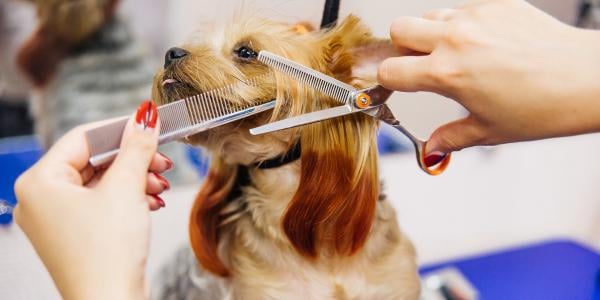 For some dogs, going to the groomer can be a dreaded experience. The idea of a bath, blow dry, nail trimming, teeth brushing, or being touched with grooming tools like clippers or shears might make them anxious.
For some dogs, going to the groomer can be a dreaded experience. The idea of a bath, blow dry, nail trimming, teeth brushing, or being touched with grooming tools like clippers or shears might make them anxious.
Having a groomer who has built a relationship with your pet can make the experience easier and safer.
The relationship between your dog and their groomer is based on trust. Both need to have confidence in each other, and neither the dog nor the groomer should be afraid of what the other one might do. After all, there is a lot of personal space being invaded while your pup is getting cleaned, cut, and coiffed!
Finding a skilled and understanding groomer is crucial in helping your dog have a positive grooming experience. Introducing grooming exercises at home and low-stress grooming appointments to puppies during their socialization period can help prevent future issues with the groomer.
In this article, I'll cover some tips to help you find the right groomer and know what to expect before, during, and after a grooming appointment. And if your dog hates going to the groomer, you'll also learn how to start helping them feel better about being groomed.
Table of Contents
Finding the Best Dog Groomer
Research Groomers Near You
Start by researching groomers in your area and asking dog-owning friends, your breeder if you have one, local rescues, and your dog trainer for referrals. You can even ask your veterinarian what they think of the groomers in your area. Some veterinary clinics may have on-site grooming facilities, or dog daycares have regular visits from mobile groomers.
It's always a good idea to visit several grooming salons; any great grooming salon has an open-door policy and encourages potential clients to visit their shop. Ask for a tour and inquire about which groomer is best with certain ages, breeds, and any other specific needs you might have. For example, short-haired dogs need brush-outs, nail trims, and a bath – not a full groom. They are wash-and-wear type grooms! Poodles, Maltese, and other long hair-coated dogs need precision grooms with groomers who are skilled with scissors and have expertise in grooming specific breeds.
Questions to Ask the Groomer
- Do they require all animals to have current vaccinations? They should!
- Do they sanitize their tables, equipment, crates, etc., between each dog? Again, they should!
- Do they use shampoos and conditioners that are gentle and environmentally appropriate?
- Do they limit the amount of time a dog is in a crate?
- Do they employ safe, humane, and dog-friendly methods? Safety and kindness are essential for any place you take your dog. It is important that all dogs on a grooming table be safely restrained to keep dogs from jumping or slipping off the table or out of the tubs.
- How do they dry their dogs (hand-blown dry, drying cages, etc.)? Find out what precautions they take to make sure that a dog never overheats or suffers heatstroke when being dried. Blow drying by hand is the safest and least stressful option.
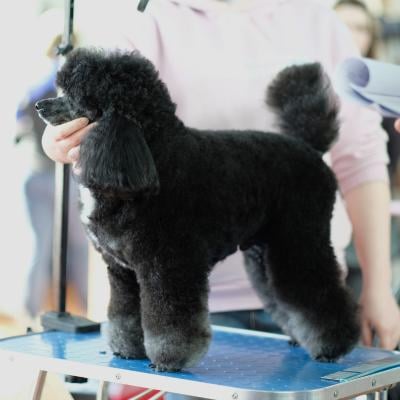 Tell Your Groomer About Your Dog and Your Grooming Expectations
Tell Your Groomer About Your Dog and Your Grooming Expectations
Inform the groomer about whether your dog has any anxiety about grooming and discuss any specific needs or limitations. Let them know if it's your dog's first time being groomed or if it's been a while since their last groom. A groomer should stop the groom if your dog exhibits moderate to high levels of stress or fear for the sake of your dog and future grooming. Make sure to let them know you are okay with this. A full groom for a nervous or anxious dog may take two or three visits to complete.
Bring along photos of the haircut you'd like your dog to have, and be as detailed as possible when talking about it with your groomer. If you don't know what would be the best cut for your dog, feel free to ask questions about what might be the "standard" for that breed or any ideas the groomer has.
If you're looking for an easy-to-maintain cut, then you likely will want to keep things short and simple. Fancier cuts often require daily maintenance or more frequent trimming. A knowledgeable groomer will listen, ask questions, and work with you to create a customized grooming plan that focuses on your dog's comfort and well-being.
How Often Should a Dog Be Groomed?
If your dog requires hair cutting as part of their coat care, then how often they need to be groomed depends on your style preferences and at-home brushing routine.
If you prefer your dog to have a longer coat, then they will require daily brushing to make sure there are no mats or tangles and will need grooming every 4 to 6 weeks.
If you prefer an easier at-home grooming routine or want to extend the time between grooms, then you will need to have your dog's coat cut short and brush them daily to prevent mats as it grows. With proper at-home brushing and coat care, you may be able to go up to 8 to 12 weeks between grooming appointments, depending on your dog's coat.
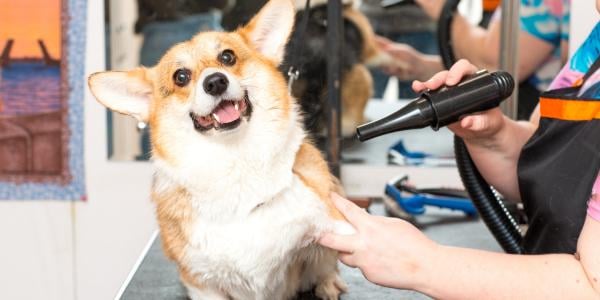
How Long Does Dog Grooming Take?
Grooming appointment lengths depend on the services being performed, the groomer's skill level, your dog's size, and their tolerance of grooming. Some grooming shops have you drop off your dog in the morning and then pick them up in the afternoon. Others have you drop off at a specific appointment time and call you to pick up your dog when they finish. This second option is ideal for most dogs, especially for those who get nervous at the groomer.
The times below are an average length for a full grooming appointment (bath, blow dry, all-over haircut) with an experienced groomer for a dog without severe matting or complex styling. Your dog's appointment time may be shorter or longer. Be sure to ask your groomer when you drop them off how long it will likely take.
- Dogs under 20 lbs: 90 minutes – 2 hours
- Dogs 21–65 lbs: 90 minutes – 2 1/2 hours
- Dogs 65+: 2–3+ hours
How Much Do Most Dog Groomers Charge?
Dog groomers charge anywhere between $50 to $200+ for a groom. While you may be surprised at the cost of grooming for your dog, it's important to remember that it is a difficult job that requires expertise, skill, and patience, and groomers deserve to be paid well for their work. The price of your dog's groom will depend on many factors, such as:
- Your local area
- The groomer's experience
- The type and condition of your dog's coat
- How long your dog's appointment takes
- The services requested (bath and blow dry only, partial groom or full groom, tooth brushing, anal gland expression, sanitary trim, etc.)
- The difficulty of handling your dog during grooming
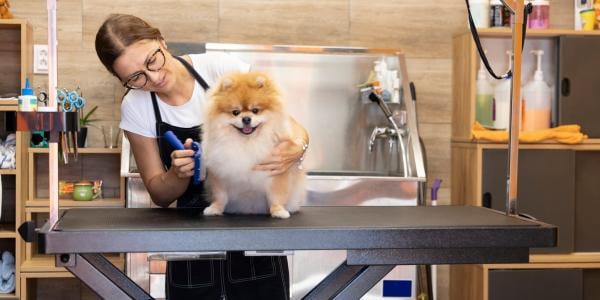
Help For Dogs Who Hate Being Groomed
It's important to understand why your dog hates being groomed. Sometimes, it can happen because of a negative past experience. Maybe they had an uncomfortable or painful grooming session, or perhaps they associate grooming with something unpleasant. It could also be a result of anxiety or fear related to unfamiliar objects or situations, which can happen if they missed early socialization to grooming and handling.
To help your dog overcome their fear of grooming, it's essential to start with desensitization and go slow. Introduce grooming tools and equipment gradually and in a positive way. Begin by simply placing the brush or clippers near your dog without using them. Reward your dog with treats and praise for remaining calm. Gradually, over several sessions, increase the level of contact with the grooming tools, always rewarding your dog's good behavior.
If your dog is particularly nervous about nail trims or having their paws handled, learn more about helping your dog feel better about nail trims here.
When helping a dog overcome fear of grooming, you must go at your dog's pace. Never force anything, as that only intensifies their fear and anxiety about grooming.
Find a quiet and comfortable space where you can groom your dog without distractions or schedule their appointment with the groomer at the quietest time of the day. Use treats and calm praise to reward your dog during the grooming process. Make sure you provide your groomer with high-value treats to use. Take frequent breaks to ensure your dog doesn't become overwhelmed. Be prepared to pay more for grooming because the appointment may take longer than usual.
It's also helpful to let your groomer know the needs vs. wants of the groom. Be willing to settle for just getting your dog bathed and brushed on one day and have to return a different day for the actual haircutting. Or your dog may not be able to sport a fancy hairdo that requires hand scissoring because all they can handle is a quick all-over trim with grooming clippers. A good groomer should never force the dog to tolerate handling for longer than they can handle when it's not a necessary procedure. A good groomer will stop a groom when a dog is exhibiting fear, stress, or anxiety and call you to pick up your dog. They may also refer you to your veterinarian for help.
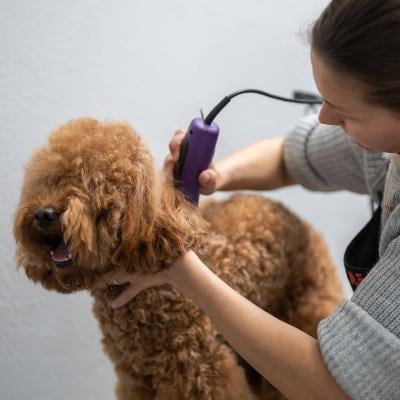 If your dog's hatred of grooming is severe, get help from a certified professional dog trainer who specializes in cooperative care training. It's also beneficial to find a fear-free certified groomer who can provide guidance and assistance in working through your dog's fear. They have the knowledge and patience to handle fearful dogs and can teach you techniques to make grooming a more positive experience for your furry friend.
If your dog's hatred of grooming is severe, get help from a certified professional dog trainer who specializes in cooperative care training. It's also beneficial to find a fear-free certified groomer who can provide guidance and assistance in working through your dog's fear. They have the knowledge and patience to handle fearful dogs and can teach you techniques to make grooming a more positive experience for your furry friend.
You can also speak with your veterinarian about helpful anxiety medications or supplements that can support your dog during grooming.
For things that must be done (such as nail trimming extremely long nails or removing matting in the coat), consider combining your veterinarian's recommended supplements or medications with muzzle training. This way, a groomer can do what is necessary without fear of being bitten. One bite to the hand and their career can be over. In severe cases, it's best to have the dog sedated at the veterinary clinic and have the grooming done there.
Remember, patience and consistency are key when helping a dog who hates being groomed. With time, practice, and lots of positive reinforcement, you can help your dog overcome their fear and make grooming a stress-free experience for both of you.
Preparing a Puppy for Grooming
Introduce Different Grooming Tools and Handling
As soon as you bring your new dog home, it's time to start introducing grooming tools and positive handling. Everything your puppy experiences during their critical socialization period (between 7-16 weeks old) has a huge impact on their future behavior. Starting positive grooming practice long before they need an actual groom will go a long way in helping them be less stressed with grooming.
Handle their paws — including touching and holding each toe individually. Follow each touch with a yummy treat. Play with and gently hold their tail. Give a treat. Play with their ears. Time for a treat! Slide your fingers along their teeth. Treat! All the time being gentle while reinforcing the experience with loving praise.
If at any point your puppy shows stress or pulls away, stop the handling and have some play time to help them relax. Try again later, ideally when they are calm and relaxed, such as right before bedtime.
Go to the Groomer for Happy Visits and Partial Groom Practice
Once your dog has received their third round of vaccinations and the grooming shop is kept clean and follows proper sanitation protocols, they can start practicing puppy grooming appointments. This may simply be a quick visit to get some cuddles and treats from the groomer while standing in the tub, playing tug with the groomer while the blow dryer is on in the background, or working on a stuffed Toppl toy while getting their nails trimmed. Over time, you can start slowly adding more of what regular grooming appointments will include. This way, your puppy will associate going into the shop with positive experiences rather than just the place where they get a B-A-T-H.
For example, check out this video of my dog Fozzie Bear, when he was a young puppy, visiting his groomer for a simple brushing and nail trimming. He worked on a stuffed Toppl at the same time to help distract and create a positive association with all of the things happening around him.
How to Introduce Your Puppy to the Blow Dryer
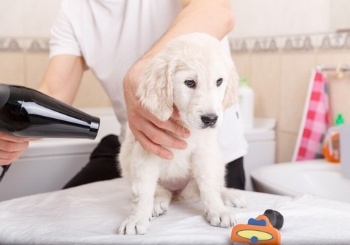 Don't use the dryer directly on your pup at first. Just let them get used to the sound. When your puppy is comfortable with the hair dryer’s sound in the background, put it on the cool and low settings and gently turn the air stream along your dog's back and shoulders. Go slow, and gradually start pointing the dryer toward them.
Don't use the dryer directly on your pup at first. Just let them get used to the sound. When your puppy is comfortable with the hair dryer’s sound in the background, put it on the cool and low settings and gently turn the air stream along your dog's back and shoulders. Go slow, and gradually start pointing the dryer toward them.
Many dogs absolutely love feeling air blow on their body and into their face — but not all do — so gradually (over time) expand the area of the body from their back to their sides, to their belly, and finally to the head and feet. This can often be successfully transitioned into a game.
Avoid blow drying their face directly, and it's often a good idea to use a Happy Hoodie calming snood over their ears to protect their hearing.
When using a hairdryer on a pet, always do so with caution. Using a dryer for too long can lead to possible burns to the coat or even their skin. One great way of making sure that you never over-dry is simply keeping your hand between your pup and the dryer. As one hand holds the hairdryer, the other can brush, scratch, rub, or even tickle your dog. If your hand starts to get too warm, then you know that it’s also too warm for your dog, and it’s time to either move to another section of their body or to put the dryer down. Give them a break for a moment and repeat your drying as needed. Make it fun, and remember to reward them during and after all this good hairdryer play.
See this video of Preventive Vet team member Finnegan learning how to feel comfortable with the blow dryer.

Make time for regular brushings
Whether they need it or not (odds are they need it!), set aside time to brush or comb your dog a little each day. If you have a pup that’s anxious or scared of combs or brushes, start off slow and make some games out of this time together. The first thing to help make this a success is getting them comfortable with these objects. Set them down, and let them look at, smell, and even lick the brush and comb. Let them know that they are harmless. (This can also apply to your pup’s nail clippers!) One nice trick is to start using the back of the comb and brush at first. Just make simple strokes across their body without the brush bristles or comb teeth touching or pulling on them. Hopefully, this will be a short-term tactic resulting in long-term results. Then, you can gradually start letting their coat go through the brush and comb.
Many groomers recommend getting the ZoomGroom as your puppy’s first brush. This sets a foundation for the tools you will need to groom at home. Depending on your puppy’s coat, you may need a firmer bristle brush and a comb. Your groomer can always make the best recommendations.
Introduce Your Puppy to Being Bathed
Though there may be a direct correlation between the size of your dog and the ease of getting them in and out of their place to bathe at home—acclimating your dog to getting wet goes a long way in helping with future grooming.
The idea here is just like their crate training — let them know that a tub is not just a safe place to be—it can also be a comforting (even fun) place to be. The key is starting slow and using plenty of your puppy's favorite things. 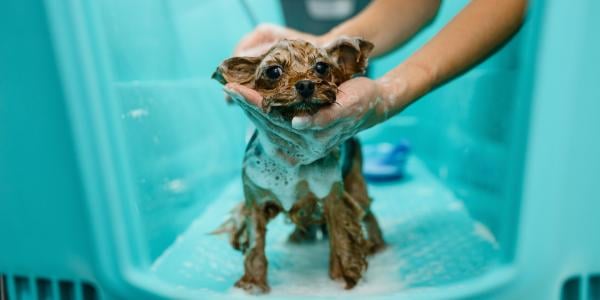
Do yourself and your puppy a favor, and begin each of these preparatory steps as soon as your dog comes to live with you in your home. All your work will pay off because each of these activities can be frustrating and stressful to dogs (of any age) if they are not properly exposed to all the elements of grooming. And if things don’t go well with any of these experiences — you too will feel frustrated.



